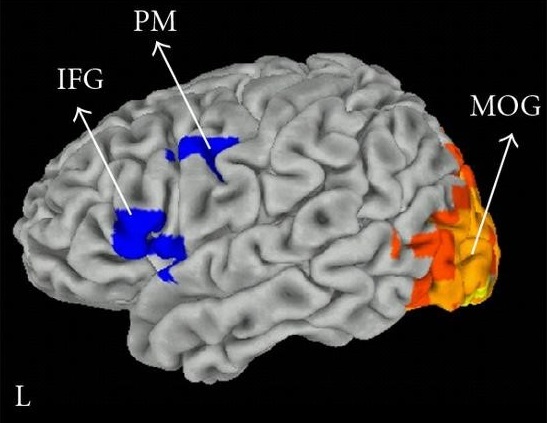Exploring the Relationship between Cortical Thickness and Cognitive Abilities: A Multi-Modal Imaging Approach
DOI:
https://doi.org/10.54133/ajms.v7i1.1247Keywords:
Cortical thickness, Cognition, Executive functions, Intelligence, MRI, Prefrontal cortexAbstract
Background: Cortical thickness has been associated with cognitive abilities in prior research, but the specific relationships remain unclear. Objectives: This study aimed to further examine associations between cortical thickness in various brain regions and performance on tests of intelligence and executive function. Methods: Structural MRI scans were obtained from 65 healthy adults aged 18-35. Cortical thickness was estimated across the cortex using Free Surfer software. Participants completed standard tests measuring IQ, working memory, cognitive flexibility, and inhibitory control. Correlation and regression analyses were used to relate regional cortical thickness to cognitive scores. Results: This study showed cortical thickness in prefrontal regions positively correlated with IQ, working memory, and cognitive flexibility. No significant associations were found between cortical thickness and response inhibition. Conclusions: The findings provide evidence for links between PFC thickness and higher cognitive abilities. A multi-modal neuroimaging approach combining structural MRI and cognitive testing is useful for elucidating brain-behavior relationships. Further research with larger samples is needed to fully characterize these associations.
Downloads
References
Cristofori I, Cohen-Zimerman S, Grafman J. Executive functions. Handb Clin Neurol. 2019;163:197-219. doi: 10.1016/B978-0-12-804281-6.00011-2.
Ali TS, Lv J, Calamante F. Gradual changes in microarchitectural properties of cortex and juxtacortical white matter: Observed by anatomical and diffusion MRI. Magn Reson Med. 2022;88(6):2485-2503. doi: 10.1002/mrm.29413.
Norbom LB, Ferschmann L, Parker N, Agartz I, Andreassen OA, Paus T, et al. New insights into the dynamic development of the cerebral cortex in childhood and adolescence: Integrating macro- and microstructural MRI findings. Prog Neurobiol. 2021;204:102109. doi: 10.1016/j.pneurobio.2021.102109.
Zhu Z, Zhao Y, Wen K, Li Q, Pan N, Fu S, et al. Cortical thickness abnormalities in patients with bipolar disorder: A systematic review and meta-analysis. J Affect Disord. 2022;300:209-218. doi: 10.1016/j.jad.2021.12.080.
Liang X, Sun L, Liao X, Lei T, Xia M, Duan D, et al. Structural connectome architecture shapes the maturation of cortical morphology from childhood to adolescence. Nat Commun. 2024;15(1):784. doi: 10.1038/s41467-024-44863-6.
Jiang W, Zhou Z, Li G, Yin W, Wu Z, Wang L, et al. Mapping the evolution of regional brain network efficiency and its association with cognitive abilities during the first twenty-eight months of life. Dev Cogn Neurosci. 2023;63:101284. doi: 10.1016/j.dcn.2023.101284.
Sheridan MA, Mukerji CE, Wade M, Humphreys KL, Garrisi K, Goel S, et al. Early deprivation alters structural brain development from middle childhood to adolescence. Sci Adv. 2022;8(40):eabn4316. doi: 10.1126/sciadv.abn4316.
Zhao C, Li D, Kong Y, Liu H, Hu Y, Niu H, et al. Transcranial photobiomodulation enhances visual working memory capacity in humans. Sci Adv. 2022;8(48):eabq3211. doi: 10.1126/sciadv.abq3211.
Friedman NP, Robbins TW. The role of prefrontal cortex in cognitive control and executive function. Neuropsychopharmacology. 2022;47(1):72-89. doi: 10.1038/s41386-021-01132-0.
Thomas MD, Sugden N, McGrath A, Rohr P, Weekes C, Skilbeck CE. Investigating the test of premorbid functioning (TOPF) in predicting Wechsler Abbreviated Scale of Intelligence - Second edition (WASI-II) scores in an Australian sample. Neuropsychol Rehabil. 2022;32(6):847-871. doi: 10.1080/09602011.2020.1842213.
Ryan JJ, Kreiner DS, Gontkovsky ST, Teichner G. Wechsler memory scale-fourth edition (WMS-IV) in the neuropsychological evaluation of patients diagnosed with probable Alzheimer's disease. Appl Neuropsychol Adult. 2023:1-8. doi: 10.1080/23279095.2023.2164858.
Hacker D, Jones CA, Chan YM, Yasin E, Clowes Z, Belli A, et al. Examining the validity of the Delis-Kaplan Executive Function System (D-KEFS) in traumatic brain injury. J Neuropsychol. 2024;18(1):81-99. doi: 10.1111/jnp.12329.
Jurick SM, Eglit GML, Delis DC, Bondi MW, Jak AJ. D-KEFS trail making test as an embedded performance validity measure. J Clin Exp Neuropsychol. 2022;44(1):62-72. doi: 10.1080/13803395.2022.2073334.
Scimeca LM, Holbrook L, Rhoads T, Cerny BM, Jennette KJ, Resch ZJ, et al. Examining conners continuous performance test-3 (CPT-3) embedded performance validity indicators in an adult clinical sample referred for ADHD evaluation. Dev Neuropsychol. 2021;46(5):347-359. doi: 10.1080/87565641.2021.1951270.
Kong F, Zhao J, You X, Xiang Y. Gratitude and the brain: Trait gratitude mediates the association between structural variations in the medial prefrontal cortex and life satisfaction. Emotion. 2020;20(6):917-926. doi: 10.1037/emo0000617.
Diveica V, Riedel MC, Salo T, Laird AR, Jackson RL, Binney RJ. Graded functional organization in the left inferior frontal gyrus: evidence from task-free and task-based functional connectivity. Cereb Cortex. 2023;33(23):11384-11399. doi: 10.1093/cercor/bhad373.
Scarfo J, Emra Suleyman, Ball M. 20 years on: Confirmation of P. Anderson's (2002) paediatric model of executive functioning in a healthy adult sample. Heliyon. 2023;9(5):e15504. doi: 10.1016/j.heliyon.2023.e15504.
Malhi GS, Das P, Outhred T, Bell E, Gessler D, Bryant R, et al. Significant age by childhood trauma interactions on grey matter volumes: A whole brain VBM analysis. Bipolar Disord. 2023;25(3):209-220. doi: 10.1111/bdi.13286.

Downloads
Published
How to Cite
Issue
Section
License
Copyright (c) 2024 Al-Rafidain Journal of Medical Sciences ( ISSN 2789-3219 )

This work is licensed under a Creative Commons Attribution-NonCommercial-ShareAlike 4.0 International License.
Published by Al-Rafidain University College. This is an open access journal issued under the CC BY-NC-SA 4.0 license (https://creativecommons.org/licenses/by-nc-sa/4.0/).











